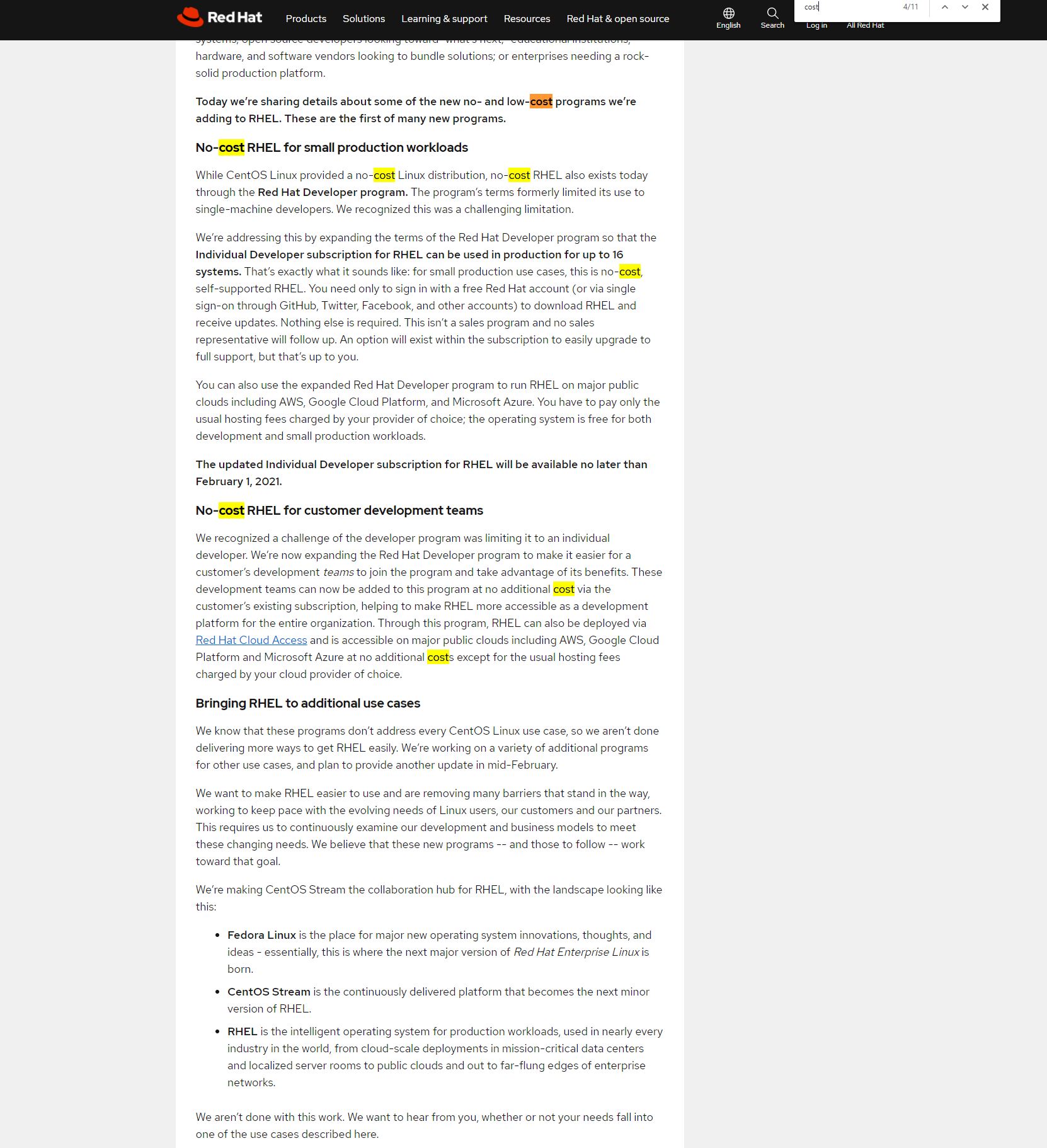In December 2020, we covered Red Hat severely constraining CentOS 8 support. Just after CentOS 6 was end-of-life, Red Hat changed the lifecycle of CentOS drastically, moving the end of support timeframe from 2029 to 2021. At the same time, the company effectively said the CentOS project as we know it is done. We have an article and video on this change as it absolutely shook the markets that had seen Red Hat as a community-friendly organization. With the purchase by IBM, that posture is changing. During that article and video, we opined that since CentOS was often an onramp to RHEL, Red Hat needed to come up with a new offering. We also noted it was a bit strange to discontinue the current version without offering a replacement. It seems like Red Hat has an answer and that is in the form of a new developer program perk.
Analyzing Red Hat Developer Program Changes
Red Hat has had its no-cost Developer Program subscription for many years. This was a primary entry point to using RHEL without having to pay for a subscription. Frankly, Red Hat needs a program like this because there is a lot of work by the developer community on any OS, including RHEL.
Before we get too far, we have a video version of this if you would prefer to listen instead:
One of the key challenges has been that the Developer Program terms formerly limited its use to single-machine developers. When we told Red Hat at conferences “we would use RHEL for server testing, but frankly licensing is too expensive for what we do.” The answer was to use the Developer Program. We, of course, could not because that limited us to a single machine while we usually have one or two dozen systems in the review production pipeline at any given time. A single machine license is great, but we are not just producing today’s content, but rather content that will go live 60-90 days from now.
Red Hat recognizes this and is making a big change:
We’re addressing this by expanding the terms of the Red Hat Developer program so that the Individual Developer subscription for RHEL can be used in production for up to 16 systems. That’s exactly what it sounds like: for small production use cases, this is no-cost, self-supported RHEL. You need only to sign in with a free Red Hat account (or via single sign-on through GitHub, Twitter, Facebook, and other accounts) to download RHEL and receive updates. Nothing else is required. This isn’t a sales program and no sales representative will follow up. An option will exist within the subscription to easily upgrade to full support, but that’s up to you.
You can also use the expanded Red Hat Developer program to run RHEL on major public clouds including AWS, Google Cloud Platform, and Microsoft Azure. You have to pay only the usual hosting fees charged by your provider of choice; the operating system is free for both development and small production workloads. (Source: Red Hat)
Sixteen production systems may seem like a lot, but I have more than sixteen Linux instances in my house just to run services such as managing WiFi, network storage, security cameras, and such. I need them to work 24×7 to keep the house running, but the main value is in the application stacks, so even a small incremental cost would cause me to switch. There is effectively no value of RHEL versus Ubuntu or Debian there. So the idea that one of my “production” licenses could be consumed by applications like those means this limitation is quite scary.
At least Red Hat is saying that it is not a sales program and that no sales representative will follow-up. We take that to mean that if you sign up for the Developer Program, per Red Hat’s language, no sales representative will reach out to you. That seems a bit strange that Red Hat would never have a sales representative follow-up on contacts in its Developer Program, but that is going to be welcome by many.
Red Hat is also extending its solution to teams through Red Hat Cloud Access to address shared development environments.
We recognized a challenge of the developer program was limiting it to an individual developer. We’re now expanding the Red Hat Developer program to make it easier for a customer’s development teams to join the program and take advantage of its benefits. These development teams can now be added to this program at no additional cost via the customer’s existing subscription, helping to make RHEL more accessible as a development platform for the entire organization. Through this program, RHEL can also be deployed via Red Hat Cloud Access and is accessible on major public clouds including AWS, Google Cloud Platform and Microsoft Azure at no additional costs except for the usual hosting fees charged by your cloud provider of choice. (Source: Red Hat)
Overall, this is good for the program irrespective of CentOS being discontinued. Great for Red Hat on enabling this.
Red Hat is acknowledging that it has more to go to address CentOS use cases:
We know that these programs don’t address every CentOS Linux use case, so we aren’t done delivering more ways to get RHEL easily. We’re working on a variety of additional programs for other use cases, and plan to provide another update in mid-February. (Source: Red Hat)
It is great to hear that Red Hat is looking at other options, but why is it communicating this in such a piecemeal fashion? Users are effectively in “limbo” with CentOS and every day of uncertainty sees more transition away from the RHEL ecosystem. As with the first announcement where a big company discontinued a line and did not announce its replacement, the communication on these changes is bizarre. Either this is going to go down as a business case study in how not to communicate a product transition, or we are seeing a symptom of Red Hat not having a plan and this is all being hastily put together.
That brings us to a heading that caught our attention. Bolded is the text we see:
Today we’re sharing details about some of the new no- and low-cost programs we’re adding to RHEL. These are the first of many new programs. (Source: Red Hat)
The term “low-cost’ is not in the remainder of the announcement. Every other “cost” is being preceded by “no” after this passage.

One could argue that the “low-cost” is referring to upgrading a subscription to full-support but in an announcement trying to qualm the community feedback from the CentOS announcement, it does not seem like the audience would deem “full-support” RHEL as “low-cost.” I may see a $1.50 bagel at my local shop as “low-cost” but it would be foolish to assume that a huge portion of the world would not see that as a lavishly expensive price.
It almost feels like RedHat had a low-cost option in this announcement, then pulled it and will announce it in February. They just forgot to change the heading. As someone who is a poor editor himself, I empathize with this, but it feels to me like it is a clue.
Final Words
This is one of the strangest series to see from a big tech company in recent memory. About a month-and-a-half after effectively discontinuing CentOS, Red Hat is expanding a developer program. Moving folks that wanted to use a download and install experience to a download, install, activate license experience where one needs to count the number of instances that are available.
What is perhaps the strangest part of this announcement is that Red Hat is slowly leaking information. For example, why did Red Hat not say in December that the Developer Program would be expanded in this fashion effective February of 2021? If there were technical limitations, then even saying Q1 2021 would have been reasonable and given some cushion. To be clear, that is effectively what Red Hat is doing today with the availability of the updated Developer Subscription being available on February 1, 2021. It is promising to bring RHEL to new use cases in mid-February 2021. If we are already setting the model where something is announced today and delivered in February, why not just announce the plans now and give an ambiguous target date.
In the meantime, to our readers, this is an absolutely awesome announcement. The expansion to 16 production systems will cover a number of use cases. Even with this coverage, Red Hat is effectively changing the interaction model for its platform from a “download and go” to a subscription model. That adds extra steps and complexity. It also means that it is putting the entire ecosystem under the control of Red Hat’s subscription services. One can take Red Hat’s word that it is going to provide these for free perhaps if you are an individual with a personal use case, but if you have anything more than that, it is much harder. Subscriptions are a recurring revenue source, but you have to trust the provider that is providing the subscription. Right now, Red Hat gutted the trust of the CentOS community it is trying to migrate.
Why this is an awesome announcement for our readers is simple. This is a massive opportunity. Red Hat is showing that it is transitioning from the old Red Hat that was admired into a more classic IBM model that is perhaps less community-friendly, despite the tone of its PR announcements. If I were a Linux admin or consultant, I would build an entire firm out of finding organizations using CentOS and helping them to transition to Ubuntu, Debian, or even OpenSUSE. That is an absolute gold mine of opportunity. I would not stop there, I would go directly after Red Hat’s RHEL once I had the process down. With CentOS seemingly discontinued at a whim, there is going to be a subset of RHEL customers that are going to be nervous, especially if they used a mixed environment.





I’d be scared of what this does to employees. At the rate they’re doing this, Red Hat employees are going to become tarnished for being anti-community when they look for new jobs.
“For example, why did Red Hat not say in December that the Developer Program would be expanded in this fashion effective February of 2021?”
The story coming out is the CentOS team was briefed on the plan then they went their own direction rather then waiting for a coordinated announcement with RH.
And it’s not going to stop the massive migration to other OS’s for the majority of the HPC world that used to use centos and gluster
One important change Patrick didn’t point out in the video, is that previously a Developer Subscription clearly didn’t allow production use. The 16 systems limit is a no-change on Red Hat’s end, as that’s already true under the current terms (I do have such a subscription).
However what we still lose with the end of CentOS is that ease of use of not having to use “subscription-manager” and having the (legal) ability of not having to use the Red Hat CDN which unfortunately tends to be rather slow. Since redistribution was OK for a rebuild such as CentOS public mirrors are easy to use. You can’t offer a public mirror of RHEL repositories without violating the subscription agreement.
@RQ that’s even worse! That’s bad precedent if Red Hat is shutting down projects without a plan to migrate. Coordinating with telling an internal team and not having a plan for users is a very anti-user message to send. It’s like saying “we don’t care about how users will react, we only care about when our team knows.” I hope that’s not really what happened.
I saw the production use in the video text.
How many billions of dollars did IBM pay for RedHat? Quite a few IIRC. Anyone who did not foresee the monetization of RedHat and all it’s works had his or her eyes closed.
Here’s another one for you: GitHub. MS paid seven or eight billion for it. In all probability we will all get an email in the next few years with some sort of “offer you can’t refuse” from MS regarding our GitHub accounts.
I think IBM has been shrinking their market share for increased shareholder profits for about 30 years. From one point of view, it’s an astonishing testimony to the breadth of IBMs original market and the depth of their technology that this has been possible for so long.
Making a habit of monetising or selling every last asset has resulted in a loss not just for IBM and every company that depends on their products but a dangerous loss of technological leadership that affects a rather large country. While good, Debian and Ubuntu Linux are not comparable to RHEL in terms of support and long term software stability. For example, RHEL 7 is based on a 3.x Linux kernel and supported until 2024 while RHEL 6 based on a 2.x kernel was only deprecated a few months ago.
As someone that has used Red Hat then CentOS since the 90’s. I can say with this obvious money grab from IBM, I will be looking to find another distribution. It’s not that I couldn’t pay a 1 time for a copy of the software like I do for windows, to help the development cost. But a subscription model, that renews annually, with a company that has proven it does not value it’s customers, only $$, means there is not future predictability with the OS in terms of cost or licensing terms which could change drastically from year to year based on the incompetence we have just witnessed.
I wouldn’t worry too much.
https://rockylinux.org/
CentOS wasn’t a competitor to Redhat, it was a competitor to other free Distros. I expect the conversion rate from CentOS users to Redhat to be tiny, likely far smaller than the benefit of people just naturally going from CentOS to the premium Redhat.
I think they should have done this in the first place and not killed CentOS.
It would have allowed dev teams to get started with RHEL, and even keep using it as small startups. Then, if they liked the overall toolset, they’d be motivated to keep on with RHEL and pay for support when they got bigger.
IBM/RH can’t really kill equivalents to CentOS, or at least they can’t without changing the way RH has been operating for years. Anyone who’s motivated to can take the source and build something like CentOS. RH has now created a gap and someone is going to step up and fill it. At least with CentOS, RH was tightly connected to the project and community. That won’t be true anymore.
Maybe an even better idea would have been to make RHEL available for free like Ubuntu is?
After all, RHEL is mainly competing with Ubuntu, and it would make some sense to roll CentOS into RHEL so there is less duplication of resources. (No offense to SuSE, but it hasn’t been common in the places I’ve worked recently.)
I would not worry that much about CentOS becoming a “prerelease branch” of RHEL. I would rather get serious security updates quickly than waiting days/weeks for it. And if you are afraid of things breaking, my advice to you is to stop updating the system for every minor issue. I have some systems that I’ve not updated in years. Most updates are unnecessary and I wouldn’t be afraid to expose SSH/HTTP to the internet unless something like heartbleed happens again. But most of my CentOS installations runs stuff in their own network segment and are only available externally through VPN.
If it is a mission-critical system where big money/HSEQ is involved, supporting RHEL is a no brainer by paying for it. If anything happens, I want RHEL support to help me troubleshoot the issue together.
I guess I just have two questions:
1. How long will that last, given the drive to make profits?
2. Have you heard of Oracle Linux? It’s the distro I’m switching to.
Quite simply, this is not enough. It’s not going to fly if your development, test, and “unsupported production” systems are still tied to license keys that need to be verified to prove that the system is “one of your 16 development instances”.
They need to do what Ubuntu does: give the bits away for free, and if you want support, you buy the support license. Heck, we’d even be ok with taking the Windows route and having it say somewhere that the instance is “not activated”.
IBM is mismanaging Red Hat into oblivion. No surprise.
Nah no more Linux crap for me..I’m back to my trusty Windows 10 ..at least I know Microsoft will never go bankrupt not even after a thousand years
This is pure FUD.
Nonsense. They are giving away RHEL for free now. Why is there a negative tone to this?
How much money did anyone reading this donate to the CentOS project when it was separate?
I rest my case.
Patrick, my feeling is that Ubuntu is really going to thank IBM for aggressively waving a white flag in the container space by taking CentOS out of the ring for LTS in containers. RHEL was never a contender, other than for the host OS. Canonical shares will definitely be on the rise lol. Now Ubuntu needs a longer LTS to make a play for the most costly host node licenses.
I don’t really see the appeal of ultra long term support. You still have to patch regularly, but bugfixes may take longer to filter down to older version of software even if you pay for them while you still forego features. Security bugs are discovered all the time and a lot aren’t new. If you don’t patch anyways then it doesn’t really make a lot of a difference what distribution you use. The sooner you get away from the pet approach to a cattle approach towards managing your systems the better.
Patrick’s example of all his IoT devices in his house is not a good one. In the first place, I doubt that anybody runs RHEL on an IoT device. It’s just not designed for that. Secondly, and more importantly, whatever Linux these devices run is under the responsibility of the manufacturer and not the user. They pay the licensing fees, if any, though of course the end-user pays that indirectly. Nobody buys bare-metal IoT devices for their home and installs the OS of their choice on them.
After the rug pulling with 8.x from 2029 to 2021, i’m not so sure I can trust Redhat with promises. I’m probably gonna migrate my environments to Rocky Linux.